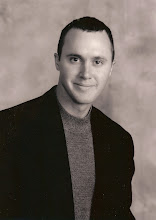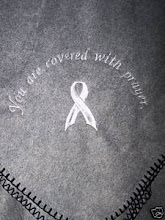Here are answers to questions about the history of Kent's health:
1) What were his symptoms?
He was experiencing some occasional numbing in his left hand and foot. This symptom did not have anything to do with the brain tumor . . . as the tumor was on the left side of his brain. An MRI of the brain on May 13, 2006 to look for Multiple Sclerosis determined that the numbing was actually caused by some herniated disks. It also showed two spots that were later determined to be tumors, one benign and one malignant. He never had a seizure . . . which is the primary indication of a brain tumor.
2) Did he have surgery?
Yes, he had surgery to remove the malignant tumor on June 14, 2006 by Dr. Hunt Batjer at Chicago's Northwestern Memorial Hospital. Dr. Batjer removed a golf ball sized tumor from his left frontal lobe. Dr. Batjer referred to the surgery as "highly successful" with 100% resection. It was so far to the front of the lobe that there was no concern for damaging any neurological functions. He did not have any deficits before or after surgery.
3) What was his diagnosis?
The pathology report read Glioblastoma Multiforme . . . or GBM IV for short.
4) What was his post-surgery treatment?
He started six weeks of concurrent IMRT radiation with 160 mg of Temodar (an oral chemotherapy) exactly two weeks after surgery.
5) What were his side-effects of post-surgery treatment?
He experienced some insomnia and an increased appetite from Decadron (an anti-swelling medication). The maximum dosage was 8 mg. He decreased to 4 mg half-way through the treatment and continued to decrease the dosage every week until the end. Toward the end, he experienced some fatigue . . . especially after tappering completely off of the Decadron and Keppra (anti-seizure medication) once treatment was finished. These medications were masking the true side-effect of fatigue from the radiation. He also returned to work on a full-time basis as a financial advisor two weeks after surgery, so this compounded his fatigue. These side-effects eventually subsided entirely. He also lost his hair in the radiated area, so he chose to shave his entire head. It started to grow back less than three months after finishing radiation and had thicker hair than before . . . but it was a little thiner on the radiated area.
6) Did he opt for extended treatment? If so, what was it?
Yes, because of his age, overall health and excellent neurological functions, he qualified for the RTOG-0525 Phase III Clinical Trial which originated at MD Anderson in Houston, TX. It's the largest brain tumor clinical trial ever undertaken. He was chosen for the standard arm of the trial which is the 5/23 Temodar plan (the 21/7 plan at a lower dosage is the trial). Four weeks after finishing the post-surgery treatment, he started this plan. He took Temodar for five days and then he was off of it for 23 days. He underwent 12 rounds of this plan . . . with his last round being in July 2007.
7) What were the side-effects of extended treatment?
He experienced some constipation from the 440 mg of Temodar and 8 mg of Zofran, an anti-nausea medication that he took before the chemotherapy. We successfully treated this with Senokot S, a laxative, three times a day, good ol' fashioned bran muffins and lots of greens. Both made him tired too, so he took Provigil as needed during this time to boost his energy.
8) Did he have a recurrence?
Yes, on January 22, 2008, an MRI revealed a new small tumor just below the empty tumor bed of the first tumor. On January 29, 2008, this tumor was 100% resected. Again, the tumor was so far to the front of the left frontal lobe that there was no concern for damaging any neurological functions, and he did not have any deficits before or after surgery.
9) Did he start a new treatment?
Yes, he started a Phase I/II trial of Temodar with Cloretazine on February 21, 2008. He took a low dose (165 mg) of Temodar for seven days in a row with a Cloretazine infusion on the seventh day . . . to be repeated every seven weeks.
10) What were the side-effects of this treatment?
He started to feel nauseaus about a day after the Cloretazine infusion. It lasted for a few days, and it was treated with Zofran, an anti-nausea medication. A side-effect of Zofran is constipation . . . which was treated with Senekot S. His platelets dropped below an acceptable level, but his bone marrow replenished the platelets rather quickly.
11) Was this treatment effective?
We are unsure of the effectiveness of the Temodar with Cloretazine, because an MRI on April 3, 2008 . . . after only one round of this treatment . . . revealed an area of concern. His doctor did not confirm if it was the start of a new tumor, ischemic changes from surgery or radiation necrosis, because it can take several months after surgery for the trauma site to settle thereby making it difficult to determine post-surgical injury or tumor recurrence. However, the area was very small with low profusion. This means there wasn't a lot of blood flow to the area . . . which is good because a lot of blood flow to the area can result in a new tumor.
12) Was his treatment changed?
Yes, as a precaution, he started his first treatment of Avastin, a growth inhibitor, with Carboplatin, a chemotherapy, on April 8, 2008. He had an Avastin infusion every two weeks with Carboplatin every four weeks. However, on July 15, 2008, his frequency of Carboplatin infusions were supposed to change to every six weeks.
13) What were the side-effects of this treatment?
He did not experience any side-effects from the Avastin, but he was nauseaus for a few days from the Carboplatin. This was unsuccessfully treated with Zofran and Kytril. Both of these anti-nausea medications cause constipation, and constipation causes nausea . . . which is what we were trying to prevent and/or alleviate. Because of this, he tried Aloxi, an intravenous anti-nausea medication that is given right before chemotherapy. It lasts up to five days with a much lower risk of constipation . . . which proved to be more effective for him.
His blood pressure was also effected, but it did not drop below acceptability. It was monitored twice a day, and we were prepared to medicate it if it dropped too low.
His WBC (white blood cell) count was effected as well. If it dropped too low, he had an Neulasta injection to increase it. His platelet count was effected too.
14) Was this change of treatment effective?
Yes, an MRI on May 6, 2008 showed a 90% shrinkage of the undefined area of concern, and an MRI on June 3, 2008 showed the remaining 10% of this area completely gone. Regardless of whether is was a recurrent tumor, ischemic changes from surgery or even residual effects from radiation, it was gone . . . after only four Avastin and two Carboplatin treatments.
An MRI on July 29, 2008 showed an empty tumor bed without any enhancement around it . . . which meant there wasn't any sign of a tumor.
15) Did he discontinue this treatment at any time?
Yes, even though the frequency of Carboplatin infusions was supposed to change to every six weeks, his doctor recommended discontinuing this chemotherapy to allow his bone marrow to recover before his next scheduled appointment on August 26th. However, he did continue with Avastin infusions every two weeks . . . as it has been successful as a single agent in preventing tumors from forming and/or growing for many people.
16) Were there any concerns with discontinuing the Carboplatin?
Yes, after a 2 1/2 month break from Carboplatin, an MRI on September 25, 2008 showed a small area of concern at the original tumor bed . . . so this chemotherapy was added back into his treatment plan with Avastin.
17) Did he ever have a seizure?
Yes, he had two grand mal seizures on 10/13/08. We do not know what caused the seizures, as they originated far from the location of the progression detected on an MRI on 10/16/08. It could have been something as simple as dehydration, fatigue and/or stress. He started taking Keppra in hopes of preventing him from having another one.
18) Was adding Carboplatin back into his treatment plan with Avastin successful?
No. Because of two grand mal seizures on 10/13/08, he had an MRI three weeks early on 10/16/08. This MRI showed a slight progression from the MRI on 9/25/08 . . . which meant the Avastin & Carboplatin combination did not work. Instead of a different chemotherapy or gamma knife, his neuro-oncologist and neuro-surgeon believed surgery was the best option . . . because the recurrent tumor was smaller than the last two that were removed. Plus, it was in an operable location with a minimal risk of deficits. This tumor was 100% resected on 10/23/08.
19) What was the treatment after his third surgery?
He started the NovoTTF-100A clinical trial of alternating electric fields entering the brain through electrodes to kill the cancer cells.
20) Was this treatment successful?
No. An MRI on 11/24/08 showed a tumor bigger than the one removed only four weeks earlier, but we decided to start the clinical trial anyway . . . because there were limited treatment options at this point with the disease. Even though an MRI on 12/30/08 showed minimal growth but a significant reduction in enhancement, an MRI on 1/20/09 showed massive growth in the left frontal lobe as well as a new tumor in the left temporal lobe.
21) What kind of end-of-life care did he have?
He started palliative care on 1/26/09 . . . which is a step above home health care and a step below hospice care. His nurse was one of his sister's friend . . . who lost her mother to GBM IV. He never entered hospice care, because we liked the options available to us through palliative care over hospice care. He died on 2/13/09.
22) Did he take any supplements?
Yes, he took calcium, fish oil, vitamin D and a multi-vitamin, and he also used a lot of flax.
23) Did he change his diet?
Yes, he was mindful of a diet suggested by his nutritionist and supported by his doctoral team.
24) Where was he treated, and who was his doctor?
He was treated by a team of doctors at Chicago's Northwestern Memorial Hospital. His neuro-surgeon was Dr. Hunt Batjer, his radiation oncologist was Dr. Mary Marymont and his neuro-oncologist was Dr. Jeffrey Raizer.
25) What was his quality of life?
For the first 29 out of 32 months of his disease, if you didn't know, you wouldn't have known.
Updated 7/09.
skip to main |
skip to sidebar


What greater testimony to the Lord's goodness can we give than to live a full and joyous life even in light of [a] great loss?, from the book Grieving the Loss of Someone You Love by Lynn Brookside & Ray Mitsch
About Me

- Bridgett
- I'm a widow and stay-at-home mother to three busy boys after losing my husband to brain cancer in February 2009. We're still grieving our loss, but God is sustaining and blessing us along the way.
Resources
These are books, websites, message boards and blogs that have helped me through my late husband's trial with brain cancer and death:
Books for Adults
- 50 Days of Heaven: Reflections That Bring Eternity to Light by Randy Alcorn
- 90 Minutes in Heaven by Don Piper
- A Grace Disguised: How the Soul Grows Through Loss by Jerry Sittser
- A Grief Observed by C.S. Lewis
- Consolation by L.B. Cowman
- From One Widow to Another by Miriam Neff
- Grace Points: Growth & Guidance in Times of Change by Jane Rubietta
- Grieving the Loss of Someone You Love by Lynn Brookside & Ray Mitsch
- Mourning Song by Joyce Landorf Heatherly
- One Minute After You Die by Erwin Lutzer
- Springs in the Valley by L.B. Cowman
- Streams in the Desert by L.B. Cowman
Books for Children
- Someone I Love Died (Please Help Me, God) by Christine Tangvald
- Wait Until Then by Randy Alcorn & Doron Ben-Ami
- What Happens When We Die? Carolyn Nystrom
- What is Heaven Like? by Beverly Lewis
Message Boards for Patients
Message Boards for Widows
Blogs That Bless Me
In Loving Memory










